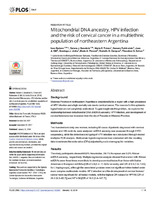Mitochondrial DNA ancestry, HPV infection and the risk of cervical cancer in a multiethnic population of northeastern Argentina
Date
2018-01-12Author
Badano, Inés
Sanabria, Daiana Jimena
Tótaro, Roxana María
Rubinstein, Samara
Gili, Juan Antonio
Liotta, Domingo Javier
Picconi, María Alejandra
Campos, Rodolfo Héctor
Schurr, Theodore G.
Metadata
Show full item recordAbstract
Background Misiones Province in northeastern Argentina is considered to be a region with a high prevalence of HPV infection and a high mortality rate due to cervical cancer. The reasons for this epidemiological trend are not completely understood. To gain insight into this problem, we explored the relationship between mitochondrial DNA (mtDNA) ancestry, HPV infection, and development of cervical lesions/cancer in women from the city of Posadas in Misiones Province.
Methods
Two hundred and sixty-one women, including 92 cases of patients diagnosed with cervical lesions and 169 controls, were analyzed. mtDNA ancestry was assessed through HVS1 sequencing, while the detection and typing of HPV infection was conducted through nested multiplex PCR analysis. Multivariate logistic regression was conducted with the resulting data to estimate the odds ratios (ORs) adjusted by socio-demographic variables.
Results
The study participants showed 68.6% Amerindian, 26.1% European and 5.3% African mtDNA ancestry, respectively. Multiple regression analysis showed that women with African mtDNAs were three times more likely to develop a cervical lesion than those with Native American or European mtDNAs [OR of 3.8 (1.2–11.5) for ancestry and OR of 3.5 (1.0–12.0) for L haplogroups], although the associated p values were not significant when tested under more complex multivariate models. HPV infection and the development of cervical lesions/cancer were significant for all tested models, with the highest OR values for HPV16 [OR of 24.2 (9.3–62.7)] and HPV-58 [OR of 19.0 (2.4–147.7)].
Conclusion
HPV infection remains a central risk factor for cervical cancer in the Posadas population. The potential role of African mtDNA ancestry opens a new avenue for future medical association studies in multiethnic populations, and will require further confirmation in large-scale studies.
Collections
The following license files are associated with this item:




